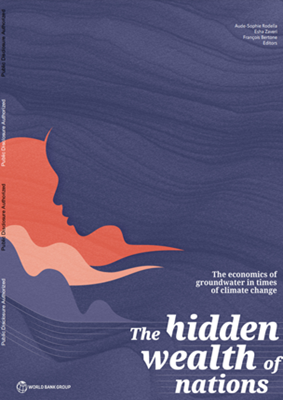Groundwater is our most important freshwater resource. But the lack of systematic analysis of its economic importance has evaded attention from policymakers and the general public—threatening the resource. Groundwater provides 49 percent of the water withdrawn for domestic use by the global population and around 43 percent of all water withdrawn for irrigation. This report offers new evidence that advances the understanding of groundwater’s value, showing how groundwater is a major asset in a country’s resource portfolio—but also the costs of its mismanagement and the opportunities to leverage its potential. In a new contribution from this research, a global aquifer typology has been developed and validated. It considers key aquifer characteristics that matter for resilient development and poverty reduction—determining the economic accessibility of the groundwater resource to individual farmers, its sustainability, and buffering capacity of the aquifer to seasonal variations and climate shocks. Along with other data sources, it enables novel global economic analysis.
New analysis shows that what groundwater lacks in visibility, it makes up for in value. At the global level, groundwater can buffer a third of the losses in economic growth caused by droughts. It is especially important for agriculture, where groundwater can reduce up to half of the losses in agricultural productivity caused by rainfall variability. By insulating farms and incomes from climatic shocks, the insurance of groundwater translates into protection against malnutrition: lack of access to shallow groundwater increases the chances of stunting among children under five by up to 20 percent. In Sub-Saharan Africa, untapped groundwater irrigation potential could be key to improving food security and poverty reduction. Little land is irrigated there, but local shallow aquifers represent over 60 percent of the groundwater resource, and 255 million people in poverty live above them.
But groundwater overexploitation exposes economies to exponential risks—including maladaptation. Globally, major alluvial aquifers account for more than 60 percent of groundwater depletion embedded in international trade—including from regions with transboundary aquifers, adding further complexity and urgency to their management. In the Middle East and South Asia, up to 92 percent of transboundary aquifers show signs of groundwater depletion. The effects of this depletion are already painfully felt in South Asia, where groundwater once provided an agricultural revenue advantage of 10-20 percent, a benefit now disappearing in areas affected by depletion. In Sub-Saharan Africa, where groundwater has been underused given its potential, expanding solar pumping without adequate safeguards could threaten rural livelihoods relying on groundwater-dependent ecosystems. A hidden risk that is becoming more visible comes from deteriorating groundwater quality because of rapidly expanding urban areas, unregulated industrial sites, and inadequate agricultural practices. Harder to measure, this quality risk presents a growing threat to groundwater sustainability and the benefits it bestows.
Faced with growing demand, groundwater’s specific features prime it for overexploitation in a classic tragedy of the commons—with exponential impacts disproportionately affecting the most vulnerable. It doesn’t have to be that way. The recommendations are informed by greater understanding of groundwater’s benefits and costs articulated around a framework of information, incentives, and investments and their corresponding policy levers. Two key dimensions are important. First is how the type of aquifer shapes the potential uses. And second is the country and regional degree of groundwater abstraction, from those who have underused the resource and have yet to harness its potential to those who have overexploited it and suffer the damaging consequences. The findings also inform the issues policymakers confront when attempting to align private and social opportunity costs of groundwater use. Urgent cross-sectoral action and high-level political mobilization are needed.

